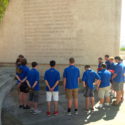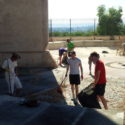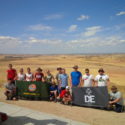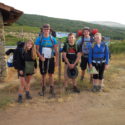Fifteen 6th form cadets from Oakham School’s CCF set off in mid-August on a 10 day expedition to explore the Peninsular battlefields of Central Spain where their forebears of the two affiliate units – Royal Anglian Regiment and Royal Logistic Corps – fought against the French during Wellington’s ultimately triumphant campaign. In particular, the battlefields of Salamanca and Talavera (both now battle honours of the Royal Anglian Regiment) were thoroughly covered to provide a real sense of the difficulties encountered in the extreme conditions of early 1800’s.
The expedition began with an overnight ferry crossing followed by a drive to Salamanca – a beautiful city of red sandstone – where a brief acclimatisation preceded the first battlefield tour around the Greater and Lesser Arapiles. Walking around the battlefield site provided a sense of the grand scale of the battle, but also of the magnitude of the battle (with regular insights into the battle picture being sprinkled into the day). The numbers of troops involved were on quite a different scale to those imaginable by modern cadets! We finished the day with a short reflection at the memorial atop the Greater Arapiles, with Cadet Sgt Major Pat Martin laying a wreath on behalf of the Essex Regiment (now 2Bn, Royal Anglian).
Following an early morning journey to the Sierra de Grados mountains on day 3, the group set about tackling one of the most beautiful and unspoilt mountain areas in Central Spain. Steep granite peaks and crisp, clearwater lagoons, not to mention 38 degree temperatures, provided strenuous challenges to all three groups of walkers as they completed their 4-day trekking phase staying in refugios and campsites en-route. Having walked from San Carlos to Goose Green on our previous Gold expedition, these peaks and these temperatures provided a whole new challenge for the cadets.
Without fuss or ceremony, day-7 saw the group travel the short but incredibly hot journey to Talavera and a night in the Hotel Perales (2*!!) luxury indeed for all. The next day saw us tackle the all-important ‘Community Day’ – something that has become an essential feature of our expeditions as it gives something back by way of effort and contribution as a balance to the assistance and support of so many stakeholders, the Ulysses Trust being a significant part. The context for this Community Day was the Battlefield memorial just North of the Talavera battlefield which, although new, has been allowed to quickly become tatty and overgrown. Armed with gloves, weed-killer, brooms, cloths and scrapers, the group spent some 6 hours putting the memorial back into a respectable condition before stopping again for a short reflection and a laying of wreaths on behalf of the RLC (for the Wagon Train ‘Peninsular’ battle honour) and the Royal Anglian Regiment (for the 48th Northamptonshire Regiment). In the searing heat, this element of the expedition again brought home just how arduous the Peninsular Campaign must have been for the soldiers fighting some 200 years previously.
With the day’s ‘work’ done, a walk across the Battlefield of Talavera and accompanying presentation provided one of the most vivid illustrations of the enormous numbers involved in this battle, and of Wellesley’s inspirational command of his English, Spanish and German troops.
With a final rest day in Madrid before returning to Blighty, the expedition finished with a final meal to reflect upon some arduous walking, some memorable battlefield tours and some awesome weather. The 15 cadets returned with an appreciation both of the Peninsular Campaign and of their real abilities under pressure. If one wanted an accurate and efficient illustration of Adventurous Training, this most certainly was it.
It is appropriate at the end of all Post-expedition reports such as this to record a number of thank-yous: firstly, the help and support of the Ulysses Trust in pump-priming such an ambitious venture was extremely helpful. They have certainly enabled all these cadets to find out a great deal about themselves; also the Regimental Headquarters of the Royal Anglian Regiment and Corps Headquarters of the Royal Logistic Corps were both supportive and encouraging of our reflections on their predecessor regiments, not to mention the cleaning up of the monument at Talavera. A final note of thanks, however, must go to Captain D.G.Wright whose staff work was first class throughout, and allowed the expedition to hit exactly the right balance between arduous trekking, informative historical development and, crucially, personal discovery for all the cadets involved.




